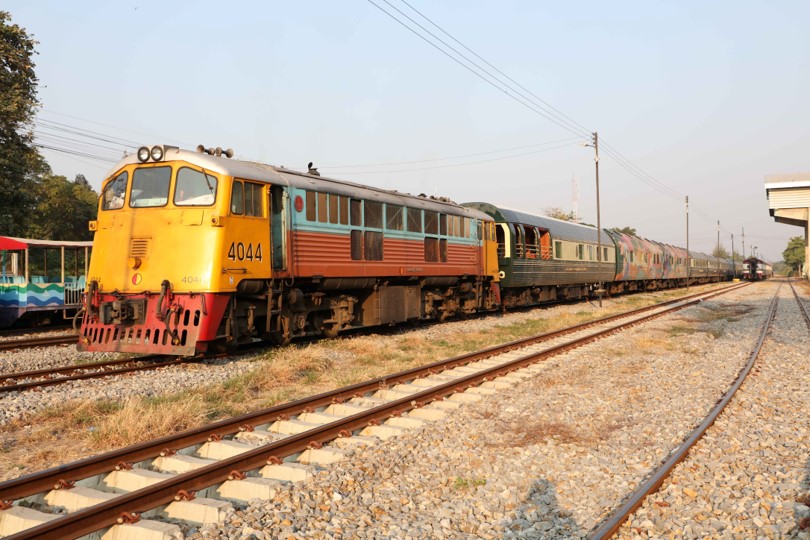19th April 2022 “Rail Travels in South-East Asia 2019” by Iain Scotchman

For our penultimate meeting of the season on April 19th we were delighted to welcome Iain Scotchman, who gave a fascinating presentation on his rail travels in South East Asia in 2019. Ian made two trips in 2019: the first in March covering North Borneo, Taiwan and South Korea and the second in December covering Malaysia, Thailand and Singapore.
The March trip began in North Borneo where Chinese investment has led to improvement and some re-openings of an otherwise dilapidated network. Here Vulcan Foundry 2-6-2 No. 6.016, which is normally used on a tourist trains between Tanjung Aru and Sabah, worked a charter for Iain’s group. A second VF loco, 6.015, was observed and stated to be in working order although it was not in steam. Otherwise, services are provided by a mixture of modern Japanese built single railcars and much older railcars built by Wickham in England.
13 days in Taiwan followed, beginning in its capital Taipei. Japan, when it was under their rule, built the first railways in the island to 3ft 6in gauge. These formed a ring around the island's coastal fringes, with various branches leading off. Today these original lines remain in use whilst a standard gauge high speed line runs North to South. In Taipei there is a heavily used and extensive network of metro and suburban lines. The Japanese influence is not only reflected in plinthed steam locomotives, but also by Japanese 'Bullet Trains' on high speed services. A visit to the old Taipei railway workshops produced an unexpected line of long disused ex-BR MkIIs! Subsequent travels elsewhere in the country led to many interesting sights: a ‘fan-shaped roundhouse’ at Changua; a trip on the popular Alsihan Tourist Railway (constructed as a narrow gauge logging railway and renowned for its three interlocking spirals, with Shay designed steam locos) and also a number of sugar mill lines where an ex-Belgium 0-6-0T was observed.
This trip's final stage was in South Korea and centred on Seoul. Its proximity to North Korea means there are several unusual tourist attractions. These include a DMU service to Dorasan station on the edge of the demilaterised zone (DMZ), a park at Imjingak where the hulk of a 4-8-2 destroyed in the Korean War is exhibited, and a North Korean submarine in a park at Gangneung. Perhaps most unusual of all is a secret invasion tunnel dug under the DMZ by North Korea into the South. Discovered in 1978 it has now become a tourist attraction fitted out with a narrow gauge railway. Elsewhere the mainline railways exhibit much overseas influence. American GE Bo-Bos and French style electric locos handle freight and shunting movements. A high speed line runs to the South from Seoul with French TGVs in use alongside more modern designs.
The primary purpose of Iain's second outing in December 2019 was to make a trip on 'The Eastern Orient Express', which runs from Bangkok to Singapore. As its name implies this train emulates the European 'Orient Express'. It is composed of ex-Japanese coaches fitted out in elegant Edwardian-era style with luxury catering and sleeping accommodation throughout.
Starting in Malaysia, Kuala Lumpur's local railway network was explored, including three trips on an elevated monorail serving the city. The old Kuala Lumpur station retains its dramatic Oriental-style façade over the tracks at its Northern end, whilst the roof has been renewed without too much loss of its original character. Moving on to Thailand and Bangkok, the modernised main station has retained its overall arched roof and its Italian-style architecture. The city's metro system is undergoing continuing expansion and a giant new central station is under construction, although largely incomplete in December 2019.
South from Kuala Lumpur the train passes over the River Kwai at Kanchanaburi. This was the point where many thousands of captured British and Commonwealth troops were sent from Singapore to work on the 'Burma Railway' or 'Railway of Death' as it is known. A short stretch survives in use for tourist trains and a large Commonwealth War Graves cemetery contains the remains of many soldiers who died working on the railway. The 'Eastern Orient Express' stopped at the bridge, as do other trains, so that passengers may walk across before reboarding the train. The train then continues South, finally terminating at Singapore. Unfortunately, the old colonial station here is closed and in the absence of any new structure passengers disembark on a single platform before undergoing rigorous entry and customs checks.
Overall, a striking feature of this presentation was the evident prosperity of this part of Asia. Many photographs had a backdrop of modern skyscrapers, motorway flyovers, and ongoing railway construction of new lines, facilities, and stations.
The meeting closed with our Chairman thanking Iain for his excellent presentation, superbly illustrated with many high quality digital images.
